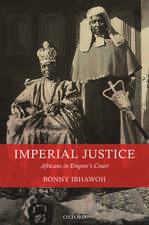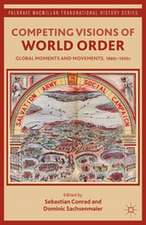Namibia's Red Line: The History of a Veterinary and Settlement Border: Palgrave Series in African Borderlands Studies
Autor G. Miescheren Limba Engleză Hardback – 12 iun 2012
| Toate formatele și edițiile | Preț | Express |
|---|---|---|
| Paperback (1) | 389.70 lei 6-8 săpt. | |
| Palgrave Macmillan US – 23 dec 2015 | 389.70 lei 6-8 săpt. | |
| Hardback (1) | 397.38 lei 6-8 săpt. | |
| Palgrave Macmillan US – 12 iun 2012 | 397.38 lei 6-8 săpt. |
Preț: 397.38 lei
Nou
Puncte Express: 596
Preț estimativ în valută:
76.04€ • 81.31$ • 63.40£
76.04€ • 81.31$ • 63.40£
Carte tipărită la comandă
Livrare economică 17 aprilie-01 mai
Preluare comenzi: 021 569.72.76
Specificații
ISBN-13: 9780230337480
ISBN-10: 0230337481
Pagini: 327
Ilustrații: XII, 327 p.
Dimensiuni: 152 x 229 x 23 mm
Greutate: 0.64 kg
Ediția:2012
Editura: Palgrave Macmillan US
Colecția Palgrave Macmillan
Seria Palgrave Series in African Borderlands Studies
Locul publicării:New York, United States
ISBN-10: 0230337481
Pagini: 327
Ilustrații: XII, 327 p.
Dimensiuni: 152 x 229 x 23 mm
Greutate: 0.64 kg
Ediția:2012
Editura: Palgrave Macmillan US
Colecția Palgrave Macmillan
Seria Palgrave Series in African Borderlands Studies
Locul publicării:New York, United States
Recenzii
'A remarkable demonstration of how focusing on topic largely ignored in African historiography, a line drawn in the sand, can produce alternative perspectives on the socio-cultural history of Namibia. This finely nuanced study opens up important ways of re-examining old ways of writing history and generates important new insights into the dynamics of colonial control.' Robert Gordon, professor, University of Vermont and University of the Free State
'Seated in an exceptional knowledge of Namibia's historical record, this work has moved the history of an internal border towards the center of the history of colonialism and empire in southern Africa. Miescher makes a convincing case that the internal border, through its development towards a formally realized settlement and veterinary boundary, may be far more determinative of the terms of governmentality, and in turn of the fate of the nation, than the external borders that were the privileged cartographic marks of empire. We learn how the internal border was experienced, how it was lived, and the work raises critical questions regarding the continuing effects of the structures of spatial colonialism on the conditions of governance and economy in the post-colony.' David William Cohen, professor emeritus of Anthropology and History, The University of Michigan
'Real and imagined, the Red Line slices through Namibia's history. Miescher provides a compelling and vivid account of an historic journey along the line as it is constantly re-mapped and re-inscribed upon the landscape, defining Namibia's space and time for almost a century and still continues to cast its shadowlike presence.' Leslie Witz, History Department, University of the Western Cape
'Giorgio Miescher's innovative study uses the Red Line as a tangential and highly productive route into Namibian history. He concludes with a more personal quest for the Red Line, exploring how this border was experienced, and how it is remembered. It is a revealing study, welding social, environmental, and veterinary themes and showing again the value of unusual vantage points in the writing of history.' William Beinart, Rhodes Professor of Race Relations, University of Oxford
'Seated in an exceptional knowledge of Namibia's historical record, this work has moved the history of an internal border towards the center of the history of colonialism and empire in southern Africa. Miescher makes a convincing case that the internal border, through its development towards a formally realized settlement and veterinary boundary, may be far more determinative of the terms of governmentality, and in turn of the fate of the nation, than the external borders that were the privileged cartographic marks of empire. We learn how the internal border was experienced, how it was lived, and the work raises critical questions regarding the continuing effects of the structures of spatial colonialism on the conditions of governance and economy in the post-colony.' David William Cohen, professor emeritus of Anthropology and History, The University of Michigan
'Real and imagined, the Red Line slices through Namibia's history. Miescher provides a compelling and vivid account of an historic journey along the line as it is constantly re-mapped and re-inscribed upon the landscape, defining Namibia's space and time for almost a century and still continues to cast its shadowlike presence.' Leslie Witz, History Department, University of the Western Cape
'Giorgio Miescher's innovative study uses the Red Line as a tangential and highly productive route into Namibian history. He concludes with a more personal quest for the Red Line, exploring how this border was experienced, and how it is remembered. It is a revealing study, welding social, environmental, and veterinary themes and showing again the value of unusual vantage points in the writing of history.' William Beinart, Rhodes Professor of Race Relations, University of Oxford
Notă biografică
Giorgio Miescher is a historian of Namibia and Southern Africa and has published on various aspects in the field. He is currently a Marie Curie Fellow of the University of Basel, Switzerland, and the University of the Western Cape, South Africa.



















